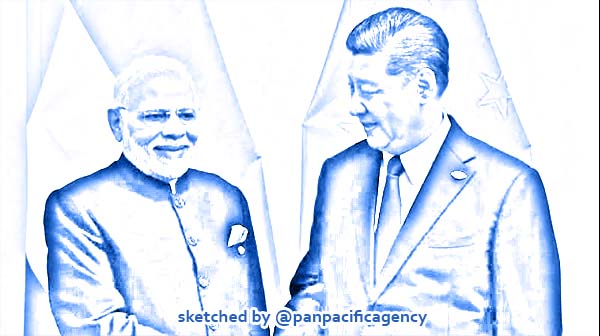[Analytics] India’s Frontier Paradox

Prime Minister Narendra Modi on Wednesday met Chinese President Xi Jinping and said there has been a "new direction and new energy" in bilateral ties after their second informal summit in Chennai as the two leaders discussed ways to further strengthen India-China relations, including on the trade front. (Photo: Twitter/ Narendra Modi). Sketched by the Pan Pacific Agency.
The ongoing India and China crisis, which led to a bloody clash on June 15, is the manifestation of a Sophoclean paradox that followed from the Narendra Modi government trying to resolve a strategic dilemma. Abhijnan Rej specially for The Diplomat.
For more than two decades – since India emerged on the global stage as a potential great power – New Delhi has struggled to reconcile its immediate geostrategic imperatives with aspirations for its future role. The ongoing military standoff with China suggests that in the process of doing so in apparently decisive terms, India may have in fact made such a reconciliation impossible.
“India’s geographical dilemma,” as Robert Kaplan described it in a 2012 book, follows from a straightforward reading of the country’s geography and history. Long disputed borders and territories with Pakistan as well as China – festering legacies of the colonial era – meant that New Delhi’s military power has remained focused on land.
At the same time, smaller states on India’s periphery – like Nepal – continue to exercise their new-found political agency in ways New Delhi is increasingly finding difficult to accept. They challenge India’s historical aspiration of soft hegemony in the eponymous subcontinent, and tax its limited diplomatic energy.
The net effect from India’s continental compulsions is that while India would much rather project power and influence across the ocean named after it, its material strategic attention has continued to be consumed by its immediate periphery. The dilemma for Delhi, then, is this. It knows that the only way for India to emerge as a leading Indo-Pacific actor is through lasting pacification of its borders, consolidation over its own territory, and stable modus vivendi with all its neighbors.
As the Indian foreign minister S. Jaishankar put it in an unusually frank public lecture in November last year: “A nation that has aspiration to become a leading power someday cannot continue with unsettled borders, an unintegrated region and under-exploited opportunities.” As such, this is a reasonable assumption.
Unfortunately, Pakistan has been far from obliging when it comes to making India’s choices easier. Judging by recent military doctrines as well as defense allocations, Rawalpindi looms large over India’s defense policy, even as its foreign policy mandarins project their country in global terms. A consequence of India’s geographical dilemma is the growing mismatch between its professed strategic intent as a leading power with global ambitions, and the diplomatic and military muscle needed to shape events far from its shores. As I have written elsewhere, this has led to a crisis of credibility when it comes to India’s interactions with other powers, big and small.
As India has sought to tame Pakistan forcefully and decisively as well as reassert its territorial claims, its military gaze has become necessarily narrow. The extant defense budget already prioritizes the manpower-extensive army as a principal instrument to manage both.
The past four years – from the special-forces operation inside Pakistan-administered Kashmir in 2016 to the Indian airstrikes inside Pakistan-proper last year – have brought a paradox at the heart of India’s efforts to resolve the geographical dilemma into sharp focus: The more New Delhi has tried to decisively tame its frontiers and unruly neighbors (the two being often interlinked), the worst it has gotten for the country in terms of expenditure of military and diplomatic efforts directed at containing the fallout of such decisions.
The most severe manifestation of India’s frontier paradox became clear this summer through the crisis with China in eastern Ladakh. As I argued in an article in The Diplomat Magazine, the Chinese reaction to India’s decision to revoke the autonomy of Jammu and Kashmir last August in order to decisively change the terms of engagement with Pakistan was, in many ways, obvious. Quite plausibly, in Chinese eyes India’s decision was a potential precursor in a revanchist plan to recover Gilgit-Baltistan (a part of Kashmir Pakistan administers and India claims). If Pakistan were to lose control of that territory in the future, significant Chinese infrastructure investments there would be at risk.
The frontier paradox has also led to unexpected strategic consequences.
Following the COVID-19 pandemic, significant tightening of India’s military spending was expected. Even before the extent of the current Chinese intrusions into Ladakh became clear, the Indian chief of defense staff, Bipin Rawat, had indicated that in the near future, India’s defense priorities will involve focusing on the country’s borders and its immediate maritime theater, and not on expeditionary capabilities.
Rawat had also suggested that India should move away from surface vessels, especially aircraft carriers, and reorient its navy toward a defensive posture using submarines instead. Other Indian defense sources had suggested – by way of rationalizing impending military spending cuts – that the “immediate requirement” for India is “a strong Army duly supported by a capable Air Force.” It is quite likely that such voices will now prevail in any inter-service bureaucratic fight. The future of Indian power projection capabilities in the Indo-Pacific is now doubly bleak, between the COVID-19 pandemic and Chinese intransigence.
This leads to the tragic corollary of India’s frontier paradox. In the process of becoming a major global actor, India ought to have first consolidated its territory and retained the ability to coerce its revisionist neighbors into submission. Having done both, it could project power freed from immediate compulsions – a necessary hallmark of a great power. But in the process of settling its immediate periphery, a chain of events has culminated in India having to double down on the very circumstances it was trying to escape.
Abhijnan Rej is Security & Defense Editor at The Diplomat.